This is Part 8 in the series. Click to see parts one, two, three, four, five, six and seven of “How to Build a Rainwater Collection System”.
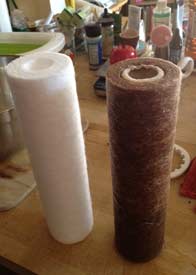 Whether potable (drinking water) or non potable (irrigation, toilet, laundry), filtration and disinfection are key to having a clean and safe source of water from your rainwater collection system. Of course, pre-screening the rainwater before it enters the storage tank is essential as discussed in part 3 of this series. Filtration for a non potable irrigation system consists of a sediment filter after the pressure pump.
Whether potable (drinking water) or non potable (irrigation, toilet, laundry), filtration and disinfection are key to having a clean and safe source of water from your rainwater collection system. Of course, pre-screening the rainwater before it enters the storage tank is essential as discussed in part 3 of this series. Filtration for a non potable irrigation system consists of a sediment filter after the pressure pump.
A 5 micron poly sediment cartridge filter will keep particles from clogging your soaker hoses and emitters. Cartridge filters come in various sizes. Smaller 2″x 8″ filters will need to be changed more often. Whereas larger cartridge filters, if not used regularly can hold bacteria and develop a bad odor. Generally for average irrigation needs, a 4″ x 10″ 5 micron poly sediment cartridge filter will do the job. Be sure to remove and discard the cartridge after the watering season so filter does not go sour during the non-use months.
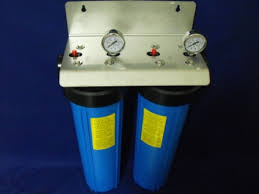 For non potable, toilet flushing and laundry facility systems, it is recommended to add a 10 Micron carbon filter. This filter will remove organics and inorganics, color and odor from you stored rainwater. By having the cheaper 5 micron sediment filter upstream of the more expensive 10 micron carbon filter you will save money by not fouling the carbon filter with particulate less than 5 Microns. Depending on how much use for this type of system, a 4″ x 20″ cartridge will mean less changing of filtration. If the system is to be shut down for a lengthy period, it is recommended that filter cartridges be removed so water will not become septic by decaying bacteria.
For non potable, toilet flushing and laundry facility systems, it is recommended to add a 10 Micron carbon filter. This filter will remove organics and inorganics, color and odor from you stored rainwater. By having the cheaper 5 micron sediment filter upstream of the more expensive 10 micron carbon filter you will save money by not fouling the carbon filter with particulate less than 5 Microns. Depending on how much use for this type of system, a 4″ x 20″ cartridge will mean less changing of filtration. If the system is to be shut down for a lengthy period, it is recommended that filter cartridges be removed so water will not become septic by decaying bacteria.
Lastly if a potable system is desired, a 1 micron absolute filter that is certified NSF 61 for cyst removal is recommended downstream from the sediment and carbon filter. A 1 micron absolute sediment filter will remove cysts but is not intended to be the final disinfection for potable water. Again, a 4″ x 20″ cartridge will mean less change outs of the filter. A 1 micron absolute filter is intended to be used in addition to UV sterilization. With the UV to be the final element in the treatment system. We will discuss UV disinfection in part 9 of this series (check the box below to receive new posts via email).
Regular inspection and maintenance of your filtration system will insure safe, and proper operation of your potable and non potable rainwater catchment system.

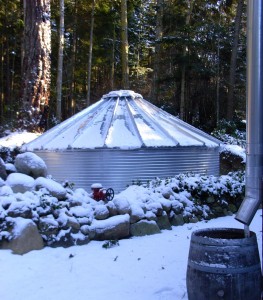 Rainwater collection is becoming increasingly popular, driven by centralized water and sewer systems unable to meet demands, incentive programs offering rebates (much like solar), water quality, availability, and cost increases from our municipal sources.
Rainwater collection is becoming increasingly popular, driven by centralized water and sewer systems unable to meet demands, incentive programs offering rebates (much like solar), water quality, availability, and cost increases from our municipal sources.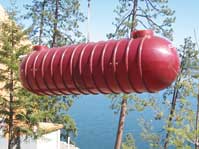 installation.
installation.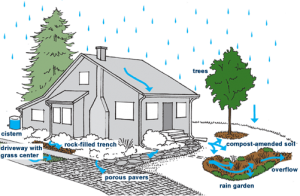 The City of Seattle, through Seattle Public Utilities, has been offering incentives in the way of rebates for rainwater collection since 2010. The
The City of Seattle, through Seattle Public Utilities, has been offering incentives in the way of rebates for rainwater collection since 2010. The